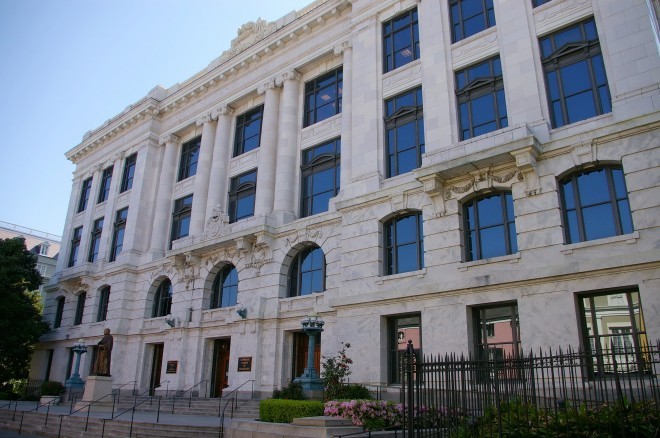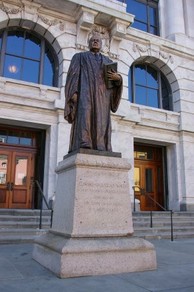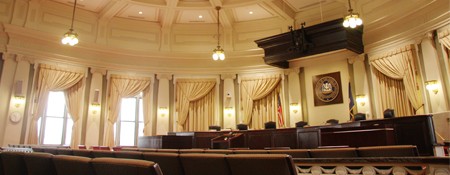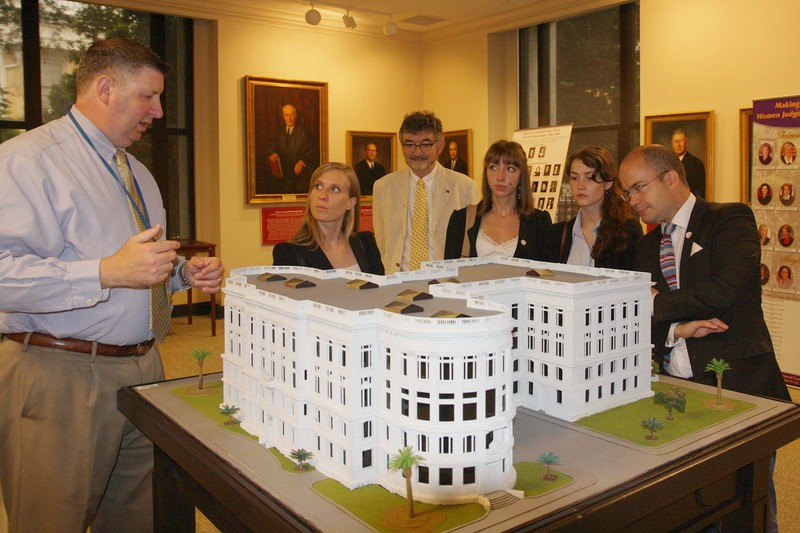Louisiana Supreme Court Building and Law Library
Introduction
Text-to-speech Audio
Images
This building houses the Louisiana Supreme Court and the Fourth Court of Appeal.

At the front of the building stands this statue of Edward Douglas White, former United States Chief Justice. White is from Louisiana and served from 1910 to 1921.

The bench where Louisiana's State Supreme Court Justices sit and preside over.

French students tour the Supreme Court Building which included the viewing of a model of the Supreme Court Building.

Backstory and Context
Text-to-speech Audio
"The Louisiana Supreme Court was first housed at Government House in New Orleans until approximately the 1820s. The Court then moved to the very crowded Presbytère, in which city offices and city and state courts in New Orleans were located. The Presbytère was sold to the City of New Orleans in 1854. Despite additions to the Presbytère to accommodate courts and their records, conditions were never ideal. Later the Supreme Court moved to the Cabildo along Jackson Square. All of the locations used by city and state courts had, over time, become cramped, dank, and unsafe. The need for a new fireproof building to house the Louisiana Supreme Court and city and state offices had been recognized as early as 1851. However, a concerted effort towards that end didn’t begin until the late 1890s.
The Louisiana Bar Association passed a resolution to build a new courthouse in 1898 and brought its lobby to that year’s state constitutional convention. The Louisiana Legislature included language in the 1898 constitution ordering the construction of a new building, and Act 79 of 1902 established a five-member Courthouse Commission to oversee the construction of a courthouse in New Orleans. The state would be responsible for building the courthouse, and the City of New Orleans would be responsible for maintaining the building.
Construction took place between 1907 and 1909, with an elaborate cornerstone-laying ceremony on January 8, 1908. The state purchased two squares in the Vieux Carré for the construction, and existing buildings were torn down, to the consternation of contemporary Vieux Carré preservationists. The Atlanta architecture firm of Brown, Brown, and Marye won the courthouse design competition sponsored by the Courthouse Commission. The firm’s design for the building was in the Beaux-Arts style, a neoclassical design fashionable at the time featuring Greco-Roman elements such as archways, columnns, and decorative fascias. The completed structure would be elegant and majestic, a fitting place for carrying out justice.
The Louisiana Supreme Court’s first session in the “New Courts Building” occurred on October 3, 1910. The building had been completed months earlier, but offices couldn’t move in until the building had been fully furnished. The Louisiana Supreme Court wasn’t the sole occupant. Orleans Civil District Court, the State Law Library, the Attorney General, and the Recorder of Mortgages were among the numerous other city and state offices housed in the building. The Supreme Court’s footprint on the fourth floor included the courtroom facing Conti Street and six other offices, including the Clerk’s Office, facing Chartres Street.
Though considered one of the finest courthouses in the nation upon its completion, inadequate funding for maintenance led to the building’s long decline. The Louisiana Supreme Court moved out in 1958 to the new Civic Center complex on Loyola Avenue. By 1982 all other agencies and offices had vacated the building for more modern spaces. (The last occupant was the Louisiana Department of Wildlife and Fisheries.) During the 1980s, lawyers and judges, remembering the building’s former glory, discussed the possibility of renovating the building and moving the Supreme Court back in. The idea took hold, and the Supreme Court of Louisiana Historical Society was founded in 1992 to support the return of the Court to its former home. Intense legislative lobbying from several interested parties secured funding to renovate and restore the building. By 2004, all restoration work was completed, and the Louisiana Supreme Court; the Law Library of Louisiana; the Louisiana Court of Appeal, Fourth Circuit; the offices of the Louisiana Judicial Administrator; and the Louisiana Attorney General moved back into an architectural gem given a second chance to shine."
Cite This Entry
Tinker, Steve. "Louisiana Supreme Court Building and Law Library." Clio: Your Guide to History. February 2, 2017. Accessed March 18, 2025. https://theclio.com/tour/121/11/reverse
Sources
The Building At 400 Royal Street. Supreme Court Of Louisiana Historical Society. Accessed January 29, 2017. http://www.sclahs.org/about-the-society/history/current-building/.
"A brief history of the Louisiana Supreme Court." Supreme Court of the State of Louisiana. 2013. Accessed February 2, 2017. https://www.lasc.org/Bicentennial/lasc_history.aspx
"Louisiana Supreme Court Building." Tulane School of Architecture. Accessed February 2, 2017. http://architecture.tulane.edu/preservation-project/place/302

